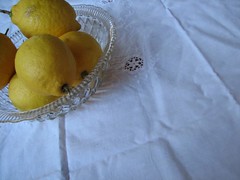Some of yesterday's lemons, destined for home made lemonade. Home grown lemons have a pleasing variety in their sizes and shapes, with odd ridges on some, and bird poop on a few.
Elizabeth Farrelly, the architecture writer for the Sydney Morning Herald, had an interesting piece in today's paper that relates to this. She begins with a Biennale exhibit involving thousands of hand made clay figures, little more than bodies with eyes, but oddly compelling. Antony Gormley's Asian Field.
To quote from her piece:
It's a quality for which English should supply a name, but doesn't. Something like unity-in-diversity would do, except for the ecumenical overtones. Or complexity-within-unity. Emergence is similar - the idea that simple units and rules can co-operate, like termites in a colony or neurons in a brain, to produce a sophisticated and self-directed whole. Emergence, though, is a concept from science, not aesthetics. And it doesn't capture the idea of essential difference, where small but myriad variations in the parts generate an extraordinary beauty in the whole.
It's a quality that occurs, if we're lucky, in buildings, street walls, facades, villages, textures and spaces. Compare, for example, a typical 17th-century brick wall with a new one. The first is warm, charming and picturesque, the second cold, chiselled, ruthless-looking. It's not just age or patina or the traditional patterns of brick-bonding, though these all help. It's that the old bricks, being handmade, are all slightly different, slightly wonky.
This simple fact gives the completed wall a softness, or humanness, to which we instinctively warm.
She goes on to talk of the garden walls in Lang St near Centennial Park "singing from the same song sheet", and the terraces of Paddington clinging up and down its steep streets, landscape dictating variation even if the basic design of adjacent houses is the same, as architectural examples of these ideas.
I'm sure, in patchwork, that this principle operates. I was talking today to another quilter. Both of us have made quilts that now, in the hands of non-quilters, have a place of honour on a wall that we never imagined. We each made relatively simple quilts, never beginning with the intention of a masterpiece, and not ending, either, with something that we considered to be one. We took care and pleasure in the making, and made quilts that pleased us. But those who own them now have them hanging as artworks.
Past a whole bunch of other arguments (I don't think we'd have been happy to find our works being trashed or treated like any old covering), there is an accessible pleasure in quilts for the nonquilter, and part of that is probably due to the handmade repetition of which Elizabeth Farrelly speaks.
Some modern art quilts can seem remote (and I've seen others that are way too much in-your-face personal, too). But pick a vintage quilt, simple blocks, pleasing colours, and you'd be hard-pressed to find many people who didn't feel drawn to it, and the non quilters at local quilt shows are equally drawn to what they see.
These lemons aren't perfect. Nor are my quilts (perfect points? Nope - they may sit flat, but the points aren't necessarily perfect). But they share this quality of simple units combining to a brain-engaging whole. I find myself liking repetition in many places. I learned a while ago that one of Nancy Crow's childhood favourites was the picture book, Mike Mulligan and his Steam Shovel, for its illustrations. I loved it then and now - for the power of its story as well as its singular and engaging illustrations. (It's by Virginia Lee Burton and is still deservedly in print: Amazon has an excellent list of classic picture books here).
NOTE: If you're interested in reading the Farrelly piece, which includes an illustration of Asian Field, the SMH lets you read stuff for 10 days free, and will then require payment. This is the full URL of the article today:
http://www.smh.com.au/news/opinion/why-halfbaked-figurines-leave-us-lost-for-words/2006/07/11/1152383739489.html
Thanks to Kt at the Department, here's a link to more information on Asian Field. Kt does some of the most amazing photography you will see. She has an extraordinary eye.








1 comment:
Hi
This coincides very much with my thoughts on modern children's toys - they are all over designed, too large, machine-made of non natural products and somewhat psychologically removed from the child. The look, feel and texture of a plastic cubby house is far different to a cubby made by the children outdoors of whatever they find, or a large sheet thrown over the kitchen table. Toys of natural products such as timber and cloth, are more touchy feely, more hands on to produce, and more interesting to look at.
Scrap quilts certainly cupply the divergence quotient for the eye to see the quilt as a mixture of different samenesses that give that delightful appeal to the eye. Though not a lover of American style blocks, I do enjoy simple block structures such as 9 patch, 16 patch, 25 patch,, strippy quilts, half and quater sqaure triangles, checkered borders, flying geese,and some log cabin variations. If I look at those in the context of the article, then they would certainly qualify if the individual patches are more scrappy than all the same fabric. A very good example is your quilt made form Moda's Cinnamon Stars fabric with the slashed triangles and 81 patch blocks. This type of quilt is very homey to me but also is a very beautiful piece to grace a wall as the focus piece of an architectural wall.
Very interesting. Thanks for bringing the article to our attention.
Cheers, Lucy
Post a Comment